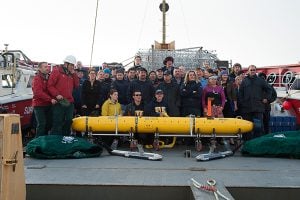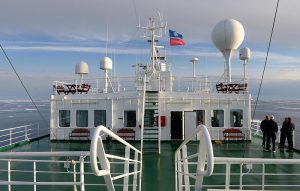
History
2014 Victoria Strait Expedition
This year's search is about much more than underwater archaeology. The Victoria Strait Expedition will contribute to northern science and communities.
- 1205 words
- 5 minutes
This article is over 5 years old and may contain outdated information.
History

After a weekend spent docked in Cambridge Bay, Nunavut, to switch sonar operators and resupply, Parks Canada’s underwater archaeology team is again aboard the research vessel Martin Bergmann, scouring the Queen Maud Gulf for signs of the lost ships of the Franklin Expedition.
“This year, the Arctic Research Foundation has brought in four competent helmsman who can help keep the boat on a straight line 24 hours a day,” says Ryan Harris, the lead of Parks Canada’s search for Erebus and Terror. “It’s been an efficient shipboard routine from the get go.”
“Using side-scan sonar can be a fatiguing process, but it isn’t terribly complex,” says Harris, watching an apparently endless stream of gravel and rock pass beneath the boat on side-by-side screens. “Sonar operators are constantly processing the altitude of the towfish [sonar unit] in the water; you don’t want to end up with the sonar hitting the sea floor.”
The gulf is being searched largely because of numerous accounts over the years from Inuit who hunt and fish in this remote part of Nunavut. Parks Canada’s searchers have met with the residents of nearby communities. They’ve been told of the masts of sunken sailing ships at or near the surface at a number of different locations. In many cases, it’s difficult for them to discern exact co-ordinates from sightings that sometimes took place years before. A recent account has even taken note of a small wooden boat turned upside down on one of the gulf’s innumerable islands.
The Queen Maud Gulf could be the only area searchers are able to reach this year. The 2014 Victoria Strait Expedition had planned to reach the point of abandonment off the coast of King William Island — where one of the ships was last seen — but heavy ice cover in the area may prevent accessing this area. Currently, ice covers upward of 90 percent of the Victoria Strait, but further south, the Queen Maud Gulf continues to hold promise.
Ice from along the west coast of King William Island pushes its way south into the gulf before melting away in waters that approach 5 C. This pattern could have carried Erebus and/or Terror into the gulf, but in its expansive waters, locating the ship’s final resting place is a daunting task.
“In this area, the sea bottom is flat and relatively featureless. If there’s a wreck down there, or just some debris, even a single plan we’re sure to spot it,” says Harris. “So far, only two objects have been interesting enough for me to take a second look at.
Unfortunately, both of them turned out to be rocks.”
Are you passionate about Canadian geography?
You can support Canadian Geographic in 3 ways:

History
This year's search is about much more than underwater archaeology. The Victoria Strait Expedition will contribute to northern science and communities.

History
Why this summer’s search for the lost ships of the Franklin Expedition will be the biggest and most advanced ever

History
First official day of the 2014 search for Sir John Franklin’s lost ships

Places
In Banff National Park, Alberta, as in protected areas across the country, managers find it difficult to balance the desire of people to experience wilderness with an imperative to conserve it